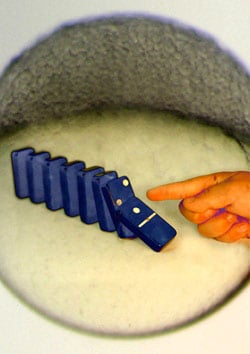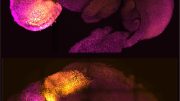
Geneticists have confirmed that three crucial factors—Nanog, Pou5f1 (also known as Oct4), and SoxB1—are essential for initiating the cascade of life in zebrafish development. Credit: Yale University
In a newly published study, Yale University geneticists report that three factors — Nanog, Pou5f1 (or Oct4) and SoxB1 — are indeed needed to push the domino of life into motion in zebrafish. These are the same factors that reprogram adult human cells into an embryonic-like state.
The basics of conception are familiar to any high school freshman biology student, yet scientists have yet to find the initial molecular mechanisms that set off the cascade of events that form a developing embryo.
Yale University geneticists report online September 22 in the journal Nature that they have identified one such trigger of life — “the finger that pushes that first domino that makes all the other ones fall and initiate the making of an embryo,” according to Antonio Giraldez, associate professor of genetics and senior author of the paper.
Scientists have known for a century that mothers provide the genetic instruction manual that drives early embryogenesis. This set of temporary maternal instructions help teach the embryo how to read its genome. However, the instructions that lead the mother to cede control of development to the incipient embryo remain undiscovered.
Giraldez and colleagues working with zebrafish measured which of those instructions are read with the highest frequency between the time of fertilization and the transfer of developmental control to the embryo — about three hours in zebrafish and 24 hours in humans.
They found that three factors — Nanog, Pou5f1 (or Oct4), and SoxB1 — had the highest level of activity and were indeed needed to push the domino of life into motion. To their surprise, these factors were the same ones that reprogram adult human cells into an embryonic-like state, a discovery that won Japanese scientist Shinya Yamanaka a share of the Nobel Prize in 2012.
“The same factors that are the fountain of youth of adult cells now provide an entry point to understanding the first domino to fall in the creation of life,” Giraldez said.
Miller T. Lee and Ashley R. Bonneau of Yale were co-lead authors of the paper. Other authors are Carter M. Takacs, Ariel A. Bazzini, Kate R. DiVito, and Elizabeth S. Fleming.
The research was supported by the National Institutes of Health, the Pew Program in Biomedical Sciences, and the Yale Scholars Program.
Reference: “Nanog, Pou5f1 and SoxB1 activate zygotic gene expression during the maternal-to-zygotic transition” by Miler T. Lee, Ashley R. Bonneau, Carter M. Takacs, Ariel A. Bazzini, Kate R. DiVito, Elizabeth S. Fleming and Antonio J. Giraldez, 22 September 2013, Nature.
DOI: 10.1038/nature12632









Nobel Laurette 2012 Shinya Yamanaka had clearly demonstrated that specialised cells are no end point from stem cells which are pluripotent and omnipotent. They can be reprogrammed backwards towards the initial stage of growth. Hence mother’s specialised cells teach the embryogenesis to become omnipotent during fertilization. Mother’s egg is taught in the embryo to fertilize and divide itself into many pluripotent fragments to become nerve, skin, blood, bone, eye, brain etc., Yamanaka also showed that only a few changes in the genomes are enough to bring about this rejuvination. We have already seen skin cells transforming into brain cells in the later research of genetics. Only a few changes in the instructions of the cells can bring about the Domino effect to go back to the starting point. Thank You.